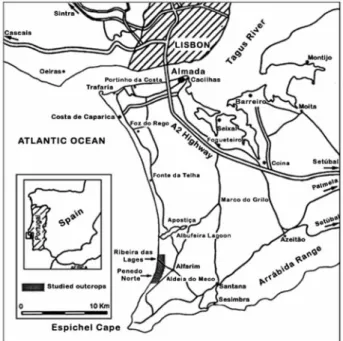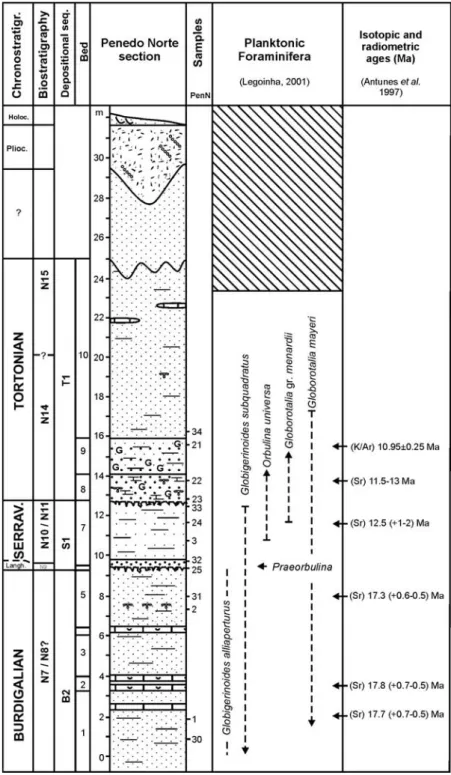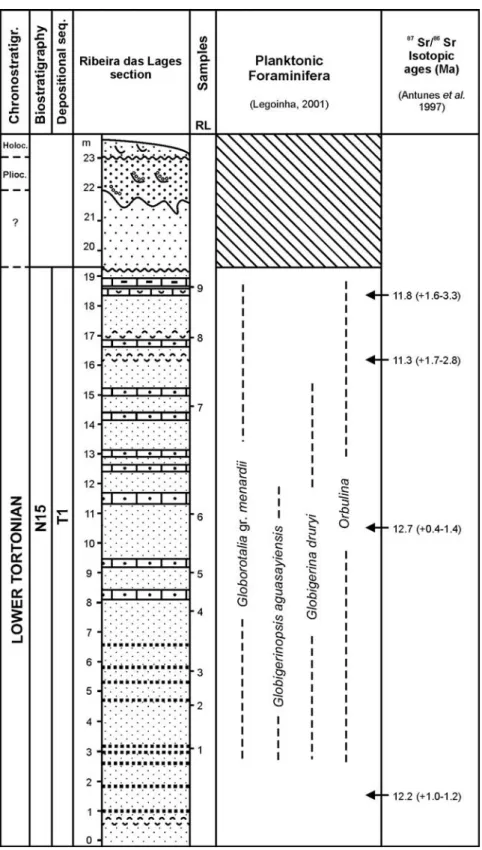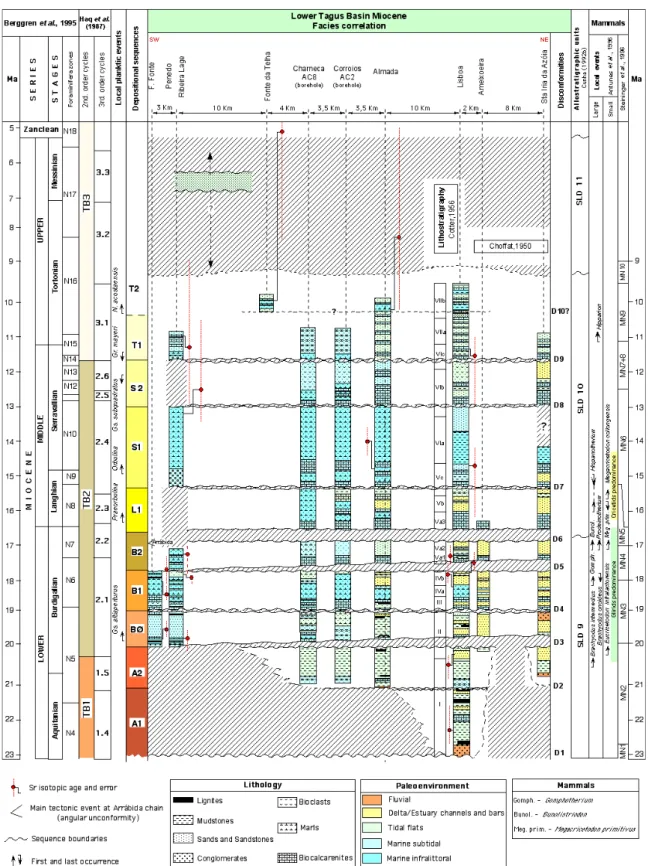Volume 6 – nº 1 2008
GEOTIC – Sociedade Geológica de Portugal
_________________________________________________________
The Serravallian-Tortonian boundary in the Lower Tagus Basin
(Portugal) and the new GSSP of the Tortonian Stage
PAULO LEGOINHA – pal@fct.unl.pt (Centro de Investigação em Ciência e Engenharia Geológica, Universidade Nova de Lisboa, Faculdade de Ciências e Tecnologia, Quinta da Torre, P-2829-516 Caparica, Portugal)
ABSTRACT: In the Lower Tagus Basin (Setúbal Peninsula, Portugal), biostratigraphic data as well as isotopic dating allowed an age of 11.6 Ma to be ascribed to the lower boundary of the local depositional sequence T1 (Antunes et al., 2000; Legoinha, 2001). Hilgen et al. (2005) announced the new GSSP of the Tortonian Stage at Monte dei Corvi (Italy) and presented the various stratigraphic tools available for global correlation. In this paper, two outcrops concerning this boundary are presented and correlated with the new GSSP of the Tortonian Stage, astronomically dated at 11.608 Ma.
KEYWORDS: Serravalian-Tortonian boundary, Foraminifera, Isotopic ages, Portugal.
1. INTRODUCTION
A comprehensive study of the chronostratigraphy of the Miocene of Portugal has been carried out by researchers of the FCT/UNL Geological Studies Centre (Antunes et al., 1992; 1996, 1997; 2000; Pais, 2004, among others). The author has studied the planktonic foraminifera from the Lower Tagus Basin and the Algarve (Legoinha, 1998; 2001; 2003; Legoinha et al., 2004).
The Miocene series from the distal sector of the Lower Tagus Basin (Lisbon region and Setúbal Peninsula) comprises a succession of mostly marine and some interfingering continental beds from lowermost Miocene (Aquitanian) to Upper Miocene (Tortonian). The stratigraphic and environmental framework is mainly based on data concerning foraminifera, ostracoda, vertebrates and palinomorphs. It was possible to obtain a fairly accurate local time scale based on both marine and continental fossils, K-Ar glauconite ages, 87Sr/86Sr dating, and paleomagnetism. Ten Miocene depositional sequences were characterized (fig. 4). The lower boundary (regional disconformity D9) of the depositional sequence T1 was dated at 11.6 Ma (Antunes et al., 2000; Legoinha, 2001) because of the last occurrence of Globigerinoides subquadratus under the disconformity (LAD: 11,8 Ma; Berggren et al., 1995) and the last occurrence of Globorotalia mayeri above the disconformity (LAD: 11,4 Ma; Berggren et al., 1995). Furthermore, a Sr isotopic age of a pectinid shell from the lowermost part of this depositional sequence yielded 11.6 Ma (+2, - 0.6). We followed Berggren et al. (1995), assuming that the Serravallian-Tortonian boundary was in the middle of the biozone N15 (Blow, 1969), dated at 11.2 Ma.
2. STUDIED SECTIONS
The two sections studied are located in the southern part of the occidental coast of Setúbal peninsula (Portugal), and present the most oceanic character concerning the Miocene infill of the Lower Tagus Basin.
Figure 1 – Location of the studied sections (Setúbal peninsula, Portugal).
2.1. The Penedo Norte section
The outcrop constitutes the northern cliffs of the Penedo beach (photo 1). GPS coordinates: 38° 27' 46'' N; 9° 11' 31'' W.
Previous studies
Romariz & Carvalho (1961, p. 83 to 94) studied the petrography and sedimentology, particularly of the glauconitic beds. The succession was ascribed to the Tortonian. Zbyszewski (et al., 1965; p. 26) and 1967 (p. 43) described the outcrop and correlated it to the local lithostratigraphic unit M VI a-b – Upper Helvetian (Cotter, 1956).
Antunes et al. (1992) studied and sketched the outcrop. They admitted that the upper part could attain the Lower Tortonian, since keeled globorotalia and some forms close to Neogloboquadrina acostaensis were found. Furthermore, K/Ar dating of the glauconitic bed yielded 10.97±0.25 Ma. Later on, another study (Antunes et al., 1997) on mollusks, foraminifera, ostracoda, vertebrates, palinology and stable isotopes ∂18O e ∂13C was presented.
Planktonic foraminifera, biostratigraphy and chronostratigraphy
The Penedo Norte lower marly beds (fig.2; beds 1 to 5) yielded Globigerina angustiumbilicata, Globigerina bulloides, Globigerinella obesa, Globigerinella pseudobesa, Globigerinoides cf. altiapertura, Globigerinoides cf. bulloideus, Globigerinoides immaturus, Globigerinoides subquadratus, Globigerinoides triloba, Globoquadrina dehiscens, Globorotalia mayeri, Globorotalia praescitula, Neogloboquadrina continuosa. This assemblage points to the upper Burdigalian (N7; Blow, 1969).
Globoquadrina dehiscens, Globoquadrina globosa, Globoquadrina praedehiscens, Orbulina suturalis, Praeorbulina cf. glomerosa, Praeorbulina transitoria. The last three species allow correlation to upper Langhian (N9). The evolutionary lineage Globigerinoides triloba – Gs. sicanus – Praeorbulina glomerosa was not found. This suggests a gap in this sector of the basin, corresponding to N8 biozone (fig. 4), which can be related with a main tectonic event in the Arrábida rangedated at 17 Ma (Pais & Legoinha, 2000).
Photo 1 – General view of Penedo Norte section (Setúbal peninsula, Portugal).
In the lowermost part of the overlying marly sandstone (fig. 2; bed 7) Globigerina angustiumbilicata, G. praebulloides, Globigerinella aequilateralis, G. obesa, G. pseudobesa, Globigerinoides bulloideus, G. obliquus, G. triloba, Globorotalia peripheroronda, G. praescitula, Orbulina suturalis, O. universa, Praeorbulina transitoria point to the Serravallian (N10). Globigerinoides subquadratus and Globorotalia cf. menardii occur at the upper part of this bed suggesting that N11, at least, is attained. In the mediterranean area Globorotalia menardii occurs within N11 (Cita et al., 1978). Miculan (1994) stated that this species is useful in recognizing the middle and upper Serravallian.
Photo 2 – Close view of bed 8 (Penedo Norte section).
2.2. The Ribeira da Lage section
This outcrop constitutes the cliffs at Moinho de Baixo beach (photo 3). GPS coordinates: 38° 29' 17.6'' N; 9° 11' 2.4'' W. The lowermost beds of this outcrop correspond to the upper part of bed 10 from the Penedo Norte section.
Previous studies
Zbyszewski et al. (1965, p. 22) assign this outcrop to the Tortonian. In 1967 (p.42-43) correlated it to the local lithostratigraphic unit Tortonian VIIa-b (Cotter, 1956). Antunes et al. (1997) attributed it to the Lower Tortonian (N15 biozone).
Planktonic foraminifera, biostratigraphy and chronostratigraphy
Sediments are medium- to fine-grained micaceous sands with intercalation of decimetric concretion beds (fig. 3). Chlamys macrotis is common at the uppermost beds. Globorotalia cf. menardii, Neogloboquadrina continuosa, Globigerina apertura, G. druryi, Globigerinopsis aguasayensis, Orbulina suturalis, O. universa and the absence of Globorotalia mayeri and Neogloboquadrina acostaensis point to the lower Tortonian (N15; Blow, 1969).
Chlamys shells were 87Sr/86Sr dated: 11.8 (+1.6-3.3) Ma, 11.3 (+1.7-2.8) Ma, 12.7 (+0.4-1.4) Ma, 12.2 (+1.0-1.2) Ma (H. Elderfield, Department of Earth Sciences, Cambridge University).
Photo 3 – General view of Ribeira da Lage section (Setúbal peninsula, Portugal). For a panoramic view see: http://www.geopor.pt/gne/ptgeol/qtvr/panora3_set.html
3. THE LOWER TAGUS BASIN T1 DEPOSITIONAL SEQUENCE AND THE GSSP OF TORTONIAN STAGE AT MONTE DEI CORVI
In the Lisbon region, the T1 depositional sequence comprises the VIc and VIIa lithostratigraphic units (Cotter, 1956). It begins with coarse biocalcarenites rich in large mollusks (unit VIc) grading upwards into thin yellowish sandstones (unit VIIa). This sequence is underlaid by a disconformity on top of fluvial/deltaic sandstones of Serravallian age, corresponding to the regressive phase of the previous depositional sequence S2 (fig. 4). Sr isotopic age of a pectinid shell from unit VIc biocalcarenites gave 11.6 (+2, - 0.6) Ma.
In the Setúbal Península (Penedo Norte section), the sequence begins with a medium-grained glauconite-rich conglomeratic sandstone, with fragments of phosphatic crusts, pectinids, echinids, fishes and cetacean bones — probably corresponding to a condensed level (Penedo Norte section, fig 2, beds 8 and 9) related to a sea level rise. Upwards the sequence shows thin muddy micaceous sands with carbonate concretions levels. In the upper part (Ribeira da Lage section, fig. 3) there are yellowish sandstones with Chlamys macrotis shell concentrations.
Considering the planktonic biostratigraphic data, the T1 depositional sequence begins in the N14 (Blow, 1969) and reaches N15. It can be accordingly correlated with the sea-level rise and highstand of cycle TB3.1 (Haq et al. 1987).
new GSSP for Tortonian stage shows that this species attains the basal Tortonian, both in the Atlantic and Mediterranean.
Figure 4 – Stratigraphic framework for the Miocene of the distal part of the Lower Tagus Basin (Antunes et al., 2000; modified in this paper).
4. CONCLUDING REMARKS
The lower boundary (regional disconformity D9) of depositional sequence T1 ascribed to 11.6 Ma (Antunes et al. 2000; Legoinha, 2001) can now be correlated with the new GSSP of the Tortonian Stage, astronomically dated at 11.608 Ma. The depositional sequence T1 is related with the 3rd order eustatic cycle 3.1 of Haq et al. (1987).
In the studied region, disconformity D8 (see fig. 4) represents a hiatus between 11, 6 Ma and 12,7 Ma. This was not recognized in previous works.
The Serravallian-Tortonian boundary is shown to be present between the last appearance of Globigerinoides subquadratus and the last appearance of Globorotalia mayeri both in the Mediterranean and in the Iberian Atlantic coast. As we could ascertain now, the first regular occurrence of Globigerina apertura is above the last occurrence of Globorotalia mayeri, in the Lower Tortonian.
We also verified that Globigerinopsis aguasayensis, an index species of the Mediterranean middle Miocene (Iacarino, 1985), attains the basal Tortonian — biozones N15 (Blow, 1969) and Globorotalia menardii s.l. (Iacarino, 1985).
Acknowledgements
I would like to thank Profs. M. Telles Antunes and J .Pais (UNL) and Lecturer I. Sacramento Grilo (SDSU) for discussion and revision of the text. Comments of Prof. Francisco Sierro (U. Salamanca) significantly improve the interpretation of the lowermost beds of T1 sequence.
References
Antunes, M.T., Pais, J. & Legoinha, P. (1992) – Excursion A. Neogene deposits of Lisboa and Setúbal peninsula. Ciências da Terra (UNL), número especial II, 29-35.
Antunes, M.T., Legoinha, P., Nascimento, A. & Pais, J. (1996) – The evolution of the Lower Tagus basin (Lisbon and Setúbal Peninsula, Portugal) from Lower to earlier Middle Miocene. Géologie de la France, nº. 4, 59-77.
Antunes, M.T., Civis, J., González-Delgado, J.A., Legoinha. P., Nascimento, A. & Pais, J. (1997) – Miocene stable isotopes (δ18O, δ13C), biostratigraphy and environments in the southern limb of Albufeira syncline (Setúbal Peninsula, Portugal. Geogaceta, Madrid, 21, 21-24.
Antunes, M.T., Legoinha, P., Cunha, P. & Pais, J. (2000) – High resolution stratigraphy and Miocene facies correlation in Lisbon and Setúbal Peninsula (Lower Tagus basin, Portugal). Ciências da Terra (UNL), vol. 14, 183-190.
Berggren, W.A., Kent, D.V., Aubry, M.-P. & Hardenbol, J. (1995) – Geochronology, time scales and global stratigraphic correlation. SEPM Special Publication, 54, 386 p.
Blow, W.H. (1969) – Late middle Eocene to recent planktonic foraminiferal biostratigraphy. Proc. First Intern. Confer. on Planktonic microfossils, Geneva 1967, v.1, 199-442.
Cotter, J.B. (1956) – O Miocénico marinho de Lisboa. Com. Serv. Geol. Portugal, Lisboa, t.XXXVI, 1-170.
Haq, B.U., Hardenbol, J. & Vail, P.R. (1987) – Chronology of fluctuating sea levels since the Triassic. Science, v. 235, 1156-1166.
Hilgen, F., Krijgsman, W., Raffi, I., Turco, E. & Zachariasse, W.-J. (2000) – Integrated stratigraphy and astronomical calibration of the Serravallian/Tortonian boundary section at Monte Gibliscemi, Sicily. Mar. Micropal., v. 38, 181-211.
Hilgen, F., Aziz, H.A., Bice, D., Iaccarino, S., Krijgsman, W., Kuiper, K., Montanari, A., Raffi, I., Turco, E. & Zachariasse, W.-J. (2005) – The Global boundary Stratotype Section and Point (GSSP) of the Tortonian Stage (Upper Miocene) at Monte Dei Corvi. Episodes, v. 28, no. 1, 6-17.
Iaccarino, S. (1985) – Mediterranean Miocene and Pliocene planktic foraminifera. in Bolli, Saunders, J. B. and Perch Nielsen, K., eds., Plankton Stratigraphy, Cambridge Univ. Press, 283-314.
Legoinha, P. (1998) – Miocene planktic foraminifera from Setúbal Peninsula (Portugal). Abs. 6th International Conference on Paleoceanography, Lisboa, pp. 151.
Legoinha, P. (2001) – Biostratigrafia de foraminíferos do Miocénico de Portugal (Bacia do Baixo Tejo e Algarve). PhD Thesis, New University of Lisbon, 238 pp.
Legoinha, P. (2003) – Upper Miocene planktonic foraminifera from Algarve (Portugal) — chronostratigraphical implications. Ciências da Terra (UNL), vol. 15, 199-208.
Legoinha, P., Sousa, L., Pais, J., Ferreira, J. & Rita Amado, A. (2004) – Miocene lithological, foraminiferal and palynological data from the Belverde borehole (Portugal). Rev. Española de Paleontología, v. 19 (2), 243-250.
Miculan, P. (1994) – Planktonic foraminiferal biostratigraphy of the middle Miocene in Italy. Bolletino della Società Paleontologica Italiana, v. 33 (3), 299-399.
Pais, J. (2004) – The Neogene of the Lower Tagus Basin (Portugal). Rev. Española Paleontologia, v. 19 (2), 229-242.
Pais, J. & Legoinha, P. (2000) – Gruta da Figueira Brava - geological setting. Memórias da Academia das Ciências de Lisboa, Classe de Ciências, v. XXXVIII, 69-81.
Romariz, C. & Carvalho, A.M.G. (1961) – Formações margo-glauconíticas do Miocénico superior a Norte do Cabo Espichel. Bol. Soc. Geol. Portugal, v. 14 (1), 83-94.
Zbyszewski, G., Ferreira, O.V., Manupella, G. & Assunção, C.T., (1965) – Carta geológica de Portugal - Notícia explicativa da folha 38-B (Setúbal). Serv. Geol. Portugal, escala 1/50000.
Zbyszewski, G. (1967) – Contribution à l’étude du Miocène de la Serra da Arrábida. Comun. Serv. Geol. Portugal, v. 51, 37-151.



